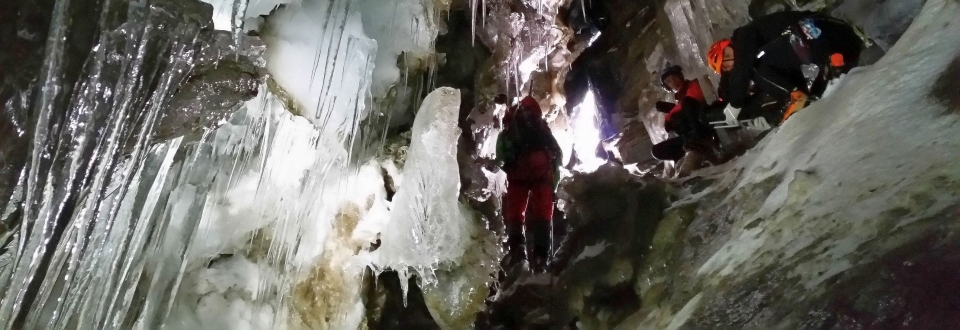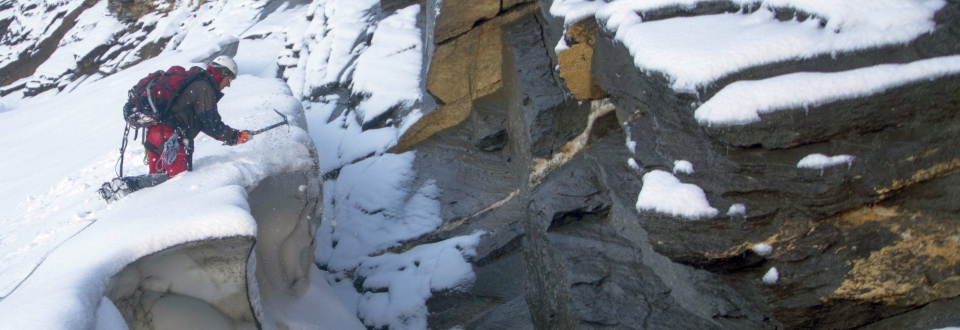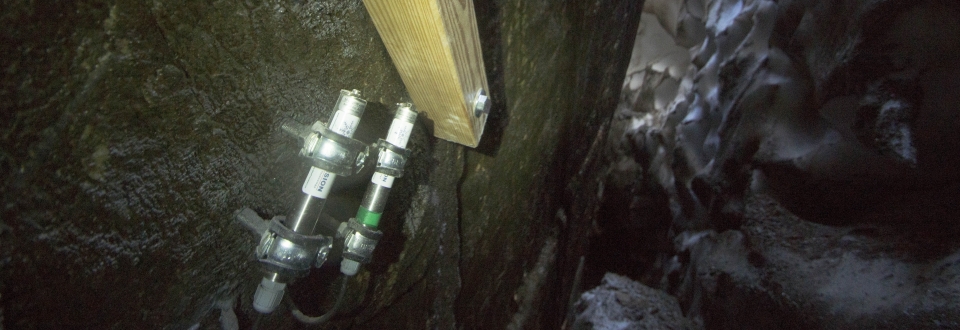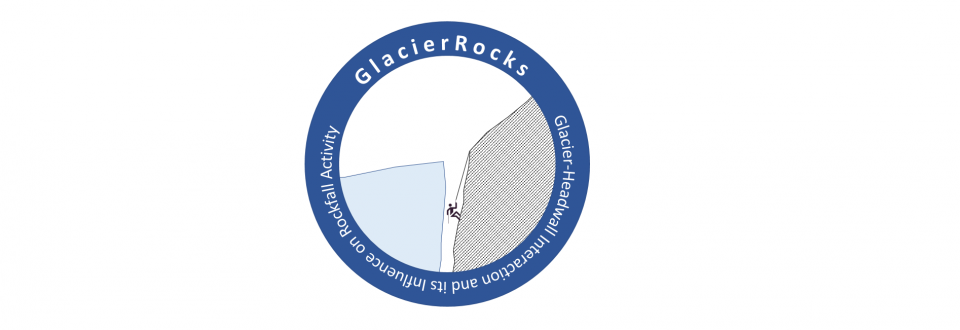PROJECT GlacierRocks
Glacier-Headwall Interaction and its Influence on Rockfall Activity
Climate models predict continued climate warming and a decrease of Austrian glaciers to less than 20% of their present area by the end of this century. Rockfall from freshly exposed headwalls has been documented as an increasing risk factor with considerable significance for man and high-alpine infrastructure. Despite these implications, little is known about the thermal, mechanical and hydrological processes that operate at the glacier-headwall interface (randkluft). Systemic in-situ monitoring of stability-relevant parameters are lacking, leaving fundamental gaps in the understanding of rockfall preconditioning in glacial headwalls and the geomorphological evolution of glaciated catchments.
The proposed project GlacierRocks will establish the worldwide first research site for long-term monitoring of stability-relevant processes inside a randkluft system. Based on the acquired monitoring data GlacierRocks is pursuing three overall aims at (1) gaining a better understanding of rockfall preconditioning in randklufts and related geomorphological shaping of headwalls, (2) analyzing poorly understood glacial thinning dynamics near headwalls, and (3) estimating present and future rockfall hazard potential in headwalls on a regional scale. We will employ an interdisciplinary and systemic methodological approach using state-of-the-art measuring and modeling techniques. The three system components (headwall, glacier, randkluft) will be investigated by combining geomorphological, glaciological and meteorological methods. GlacierRocks will continuously monitor rock temperature, rock moisture, frost cracking, glacier ice temperature, glacier ice motion, randkluft depth/width changes and a series of meteorological parameters.
The study site of GlacierRocks is located in the summit region of the Kitzsteinhorn (3.203 m a.s.l.), which is home to an interdisciplinary Open Air Lab (OAL) focusing on permafrost and rockfall monitoring. Utilizing the existing infrastructure of the OAL and collaborating with several Kitzsteinhorn-based partner projects, GlacierRocks will create unique synergy effects. An international cooperation of researchers from five institutions in Austria, Germany and Switzerland will combine expertise from geomorphology, glaciology and geology, to create the necessary interdisciplinary skills base to successfully accomplish GlacierRocks.
SELECTED REFERENCES
Hartmeyer I., Helfricht K., Leith K., Keuschnig M., Ewald A., Delleske R., Otto J.-C., Krautblatter M. (2020): GlacierRocks - Glacier-Headwall Interaction and its Influence on Rockfall Activity, Final Report (2017-2020). Austrian Academy of Sciences, ISBN-13 Online: 978-3-7001-8361-7, doi:10.1553/ESS-GlacierRockss1.
Hartmeyer I., Delleske R., Keuschnig M., Krautblatter M., Lang A., Schrott L., and Otto J.-C.: Current glacier recession causes significant rockfall increase: the immediate paraglacial response of deglaciating cirque walls. Earth Surface Dynamics, 8, 729–751, https://doi.org/10.5194/esurf-8-729-2020.
Hartmeyer I., Keuschnig M., Delleske R., Krautblatter M., Lang A., Schrott L., Prasicek G., Otto J.-C. (2020): A 6-year lidar survey reveals enhanced rockwall retreat and modified rockfall magnitudes/frequencies in deglaciating cirques. Earth Surface Dynamics, 8, 753–768, https://doi.org/10.5194/esurf-8-753-2020.
Helfricht K., Hartmeyer I., Keuschnig M., Krautblatter M., Leith K., Otto J.-C. (2019): Microclimate and temperature distribution inside a randkluft system – first observations and insights. Poster presentation at EMS Annual Meeting 2019, Copenhagen, Denmark, Vol. 16, EMS2019-90.
Hartmeyer I., Keuschnig M., Helfricht K., Leith K., Otto J.-C., Krautblatter M. (2018): Thinning Glaciers, Falling Rocks? Recent glacier retreat and its contribution to increased high-alpine rockfall activity. Poster presentation at the 10th AK Permafrost 30. November - 2. December 2018, Bremerhaven, Deutschland.
Hartmeyer I., Keuschnig M., Helfricht K., Leith K., Otto J.-C., Krautblatter M. (2018): Thinning Glaciers, Falling Rocks? The intriguing (and unknown) contribution of recent glacier retreat to increased high-alpine rockfall activity. Poster presentation at 19. Österreichischer Klimatag, 23.-25. April 2018, Salzburg.
Helfricht K., Hartmeyer I., Keuschnig M., Krautblatter K., Leith K., Otto J.-C. (2018): GlacierRocks - Wechselwirkungen zwischen Gletscher und Felswand in Randklüften und deren Auswirkungen auf die Steinschlag-Aktivität. Poster Presentation at the Jahrestagung des AK Hochgebirge, 2.-4. Februar 2018, Innsbruck.
Hartmeyer I., Keuschnig M., Fegerl L., Valentin G., Helfricht K., Otto J.-C. (2017): Long-term monitoring of climate-sensitive cirques in the Hohe Tauern range. Talk at the 6th International Symposium for Research in Protected Areas 2017, Salzburg, Österreich.
Keuschnig M. & Hartmeyer I. (2017): The Open Air Lab Kitzsteinhorn (OpAL) – Open Innovation in High Altitude. Poster Presentation at the 6th International Symposium for Research in Protected Areas 2017, Salzburg, Österreich.
Hartmeyer I. & Keuschnig M. (2017): GlacierRocks - Glacier-Headwall Interaction and its Influence on Rockfall Activity. Talk at AK Permafrost 2017, 09.-11.02.2017, Einsiedeln, Schweiz.
Hartmeyer I., Keuschnig M., Krautblatter M., Helfricht K., Otto J.-C., Leith K. (2017): Glacial Thinning and its Influence on Rockfall Activity: Introducing a new high-alpine Monitoring Site. Poster presentation at the EGU General Assembly 2017, Geophysical Research Abstracts Vol. 19, EGU2017-14921.
Am Seil die Gletscherkluft erforschen. Die Presse, 01.07.2017, Seite 26.




